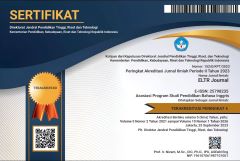THE EFFECTIVENESS OF PEER FEEDBACK THROUGH INSTAGRAM ON TENTH-GRADE STUDENTS’ SPEAKING SKILLS IN AN EFL HIGH SCHOOL
Abstrak terlihat: 1717 / PDF terunduh: 388DOI:
https://doi.org/10.37147/eltr.v8i1.181Keywords:
Instagram, peer feedback, speaking skill, traditionalAbstract
In the flow of learning objectives (ATP), students are required to master speaking skills, especially in the aspects of pronunciation, fluency, and accuracy. Students need help getting it, and one of the causes is the need for more effective learning media. This research aims to find out the effectiveness of peer feedback through Instagram on tenth-grade students' speaking skills at SMAN 1 Gamping. This research was carried out at SMAN 1 Gamping and used quantitative methods with a quasi-experimental design. Class X B is the control class that is treated with traditional peer feedback. In contrast, class X C is the experimental class that is treated with peer feedback through Instagram. The instrument used was a test (speaking skill) with the following research steps: pre-test – treatment – post-test. The hypothesis test used is the t-test with = 5% (0.05). The paired sample t-test proves that peer feedback through Instagram is effective in improving tenth-grade students' speaking skills at SMAN 1 Gamping. The independent sample proves that traditional peer feedback is superior and is more recommended for implementation.
Downloads
References
Ainia, D. K. (2020). Merdeka belajar dalam pandangan Ki Hadjar Dewantara dan relevansinya bagi pengembangan pendidikan karakter. Jurnal Filsafat Indonesia, 3(3), 95–101.
Alfarisy, F. (2021). Kebijakan pembelajaran Bahasa Inggris di Indonesia dalam perspektif pembentukan warga dunia dengan kompetensi antarbudaya. Jurnal Ilmiah Profesi Pendidikan, 6(3), 303–313. https://doi.org/10.29303/jipp.v6i3.207
Berk, L. E. (2012). Infant, children, and adolescents (7th ed.). Boston, MA: Pearson Education.
Brown, H. D. (2004). Language assessment: Principles and classroom practices (Nachdr.). New York, NY: Longman.
Creswell, J. W. (2017). Research design—Pendekatan metode kualitatif, kuantitatif, dan campuran (4th ed.). Yogyakarta: Pustaka Pelajar.
Djudin, T. (2013). Stastistika parametrik—Dasar pemikiran dan penerapannya dalam penelitian (1st ed.). Yogyakarta: Tiara Wacana.
Handayani, F. (2016). Instagram as a teaching tool? really?. Proceedings of the Fourth International Seminar on English Language and Teaching (ISELT-4), 320-327.
Hardani, H. A., Ustiawaty, J., Utami, E.F., Istiqomah, R.R., Fardani, R.A., Sukmana, D.J., & Auliya, N.H. (2020). Metode penelitian kualitatif dan kuantitatif (1st ed.). Yogyakarta: Pustaka Ilmu.
Harmer, J. (1998). How to teach English (7th ed.). Harlow: Pearson Education Limited.
Harmer, J. (2007). The practice of English language teaching (4th ed.). Harlow: Pearson Education Limited.
Hyland, K., & Hyland, F. (2006). Feedback on second language students’ writing. Language Teaching, 39(2), 83–101. https://doi.org/10.1017/S0261444806003399
Irawan, R., & Wiyanah, S. (2021). Asynchronous peer feedback in EFL writing. Proceedings UPY International Conference on Applied Science and Education, 2(1).
Ishak, S. M. M., & Yaacob, A. (2022). Enhancing ESL students’ speaking motivation through Instagram (IG). Practitioner Research, 4, 53–69. https://doi.org/10.32890/pr2022.4.4
Lauder, A. (2008). The status and function of English in Indonesia: A review of key. Makara Human Behavior Studies in Asia, 12(1), 9-20. https://doi.org/10.7454/mssh.v12i1.128
Lei, Z. (2017). Salience of student written feedback by peer-revision in EFL writing class. English Language Teaching, 10(12), 151-157. https://doi.org/10.5539/elt.v10n12p151
Lestari, K. E., & Zakarsyi, M. W. (2017). Penelitian pendidikan matematika. Bandung: Refika Aditama.
McDonough, J., Shaw, C., & Masuhara, H. (2013). Materials and methods in ELT?: A teacher’s guide (3rd ed.). London: Blackwell Publishing Ltd.
Pikhart, M., & Botezat, O. (2021). The impact of the use of social media on second language acquisition. Procedia Computer Science, 192, 1621–1628. https://doi.org/10.1016/j.procs.2021.08.166
Siregar, S. (2013). Metode penelitian kuantitatif (1st ed.). Jakarta: Kencana Prenada Media Group.
Sugiyono, S. (2013). Metode penelitian kuantitatif kualitatif dan R&D (19th ed.). Bandung: Alfabeta.
Tanjung, Z., & Amelia, S. (2017). Menumbuhkan kepercayaan diri siswa. JRTI (Jurnal Riset Tindakan Indonesia), 2(2), 1-4. https://doi.org/10.29210/3003205000
Tseng, S.-S., & Yeh, H.-C. (2019). The impact of video and written feedback on student preferences of English speaking practice. Language Learning, 23(2), 145-158. https://doi.org/10125/44687
Usmirawati, E. (2021). Alur dan tujuan pembelajaran Bahasa Inggis (SMA).
Wahyuningsih, S., & Afandi, M. (2020). Investigating English speaking problems: Implications for speaking curriculum development in Indonesia. European Journal of Educational Research, 9(3), 967–977. https://doi.org/10.12973/eu-jer.9.3.967
Wisniewski, B., Zierer, K., & Hattie, J. (2020). The power of feedback revisited: A meta-analysis of educational feedback research. Frontiers in Psychology, 10, 3087. https://doi.org/10.3389/fpsyg.2019.03087
Downloads
Published
How to Cite
Issue
Section
License
Copyright (c) 2024 Renita, Rifki Irawan

This work is licensed under a Creative Commons Attribution-ShareAlike 4.0 International License.













